Table of Contents
- Introduction
- Editor’s Choice
- Mountain Tourist Arrivals Globally
- Leading Activities Related to Mountain Tourism Worldwide
- Longest Hiking Routes in the World
- Death Rates of Mountains Worldwide
- Causes of Hiking Accident, Deaths Across Various Altitudes Statistics
- Terrain Around Hiking Accident Sites Across Various Altitudes Statistics
- Hiking Accidents in Asia-Pacific Statistics
- Hiking Accidents in North America Statistics
- Hiking Accidents in Europe Statistics
- Age Dynamics in Hiking Accident Statistics
- Gender Dynamics in Hiking Accident Statistics
- Rescue for Hiking Accident Statistics
- Initiatives to Reduce Hiking Accident Statistics
- Recent Developments
- Conclusion
- FAQs
Introduction
Hiking Accident Statistics: Hiking accidents can arise from various factors, including environmental hazards, navigation errors, physical limitations, wildlife encounters, and falls.
To prevent such incidents, hikers should engage in thorough preparation, including researching trails, assessing physical fitness, and monitoring weather conditions.
Hiking with a group, using proper equipment, and informing someone of the hiking plan can enhance safety.
In the event of an accident, it is essential to assess the situation, provide first aid, communicate with emergency services, and establish an evacuation plan if necessary.
Understanding these risks and implementing preventive strategies can significantly enhance safety during hiking activities.

Editor’s Choice
- The Air Ambulance Market size is expected to be worth around USD 47.1 Billion by 2032 from USD 17.5 Billion in 2022.
- As of December 2022, walking and hiking emerged as the most popular activities associated with mountain tourism worldwide, with 93% of respondents identifying it as a leading activity.
- As of May 2023, Annapurna I has the highest summit-to-death ratio among major mountains worldwide, with 27.2% of climbers who reach the summit not surviving.
- In hiking deaths across various altitudes, traumatic brain injury emerged as the leading cause, accounting for 74% of all fatalities.
- The terrain surrounding hiking accident sites varies significantly across altitudes. Overall, rocky terrain was the most common environment, present in 62.3% of accident sites.
- In India, mountain climbing and trekking accidents result in a high fatality rate, with deaths accounting for 61% of all outcomes, indicating a significant risk associated with these activities.
- Between 1947 and 2018, data collected from the “Accidents in North American Mountaineering” booklets reported a total of 2,799 people involved in mountaineering accidents, with 43% of these accidents resulting in fatalities.
- In 2022, the Scottish Mountain Rescue (SMR) teams responded to 709 callouts and dedicated 24,545 hours to rescue operations, making it one of their busiest years within this timeframe.

Mountain Tourist Arrivals Globally
- As of December 2022, the distribution of tourist arrivals visiting destinations for mountain tourism worldwide is varied across different percentage brackets.
- Approximately 28% of tourist destinations attracted less than 5% of total tourist arrivals, indicating a relatively low share of visits in these areas.
- Destinations that received between 5% and 10% of tourist arrivals comprised 7% of the distribution.
- Those with a slightly higher share, ranging from 10% to 20%, accounted for 24% of destinations, while destinations with a 20% to 40% share of tourist arrivals represented 21%.
- A smaller segment, amounting to 10% of destinations, had a share of 40% to 60% of tourist arrivals.
- Lastly, destinations where mountain tourism accounts for more than 60% of tourist arrivals constituted another 10%, reflecting a limited but significant focus on mountain tourism in these areas.
(Source: Statista)
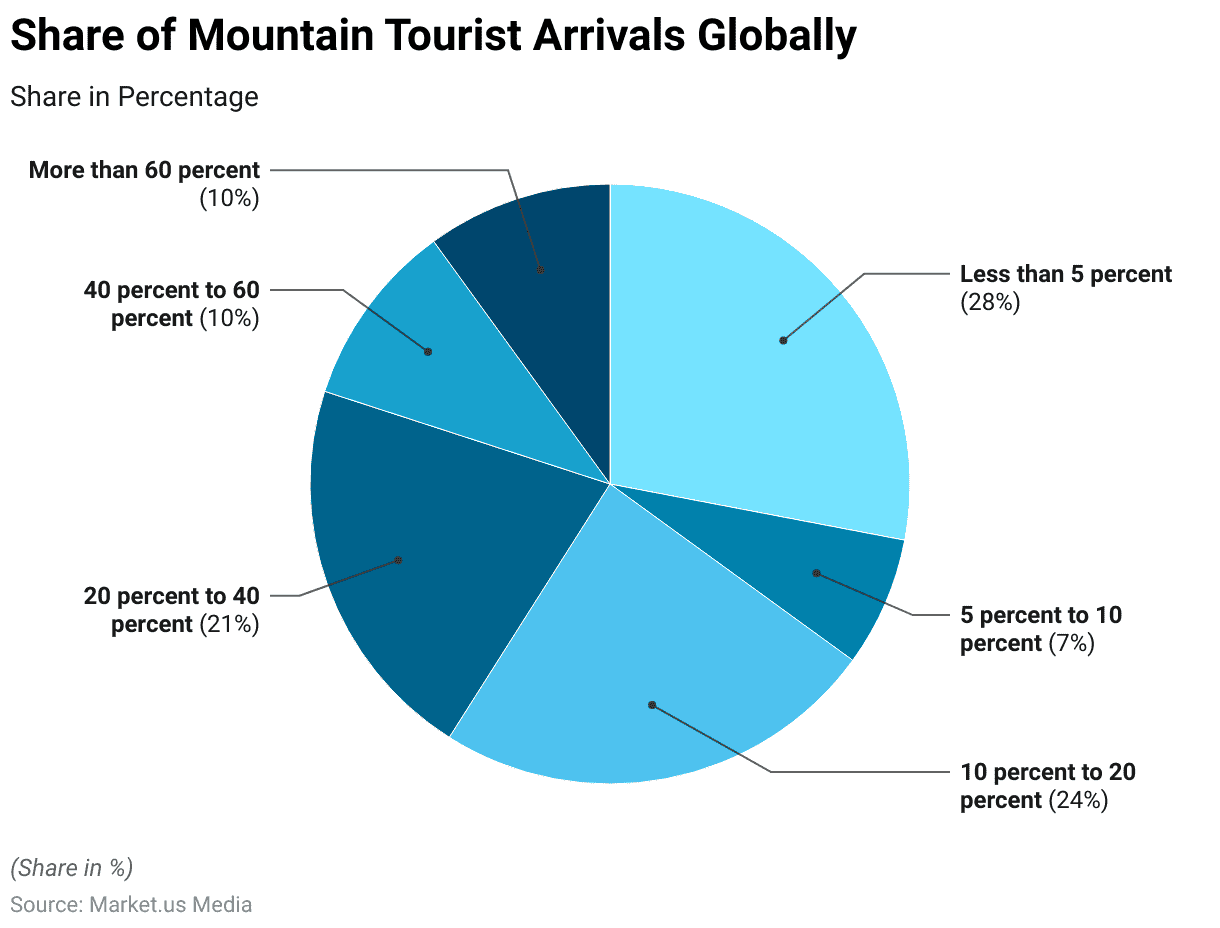
Leading Activities Related to Mountain Tourism Worldwide
- As of December 2022, walking and hiking emerged as the most popular activities associated with mountain tourism worldwide, with 93% of respondents identifying it as a leading activity.
- Nature tourism followed closely, attracting 83% of respondents, indicating a strong interest in natural landscapes and outdoor experiences.
- Rural tourism also held considerable appeal, engaging 57% of respondents.
- Winter sports activities, which include skiing and snowboarding, were favored by 50% of respondents, reflecting a significant demand for seasonal and adventure activities in mountainous regions.
- Cultural heritage activities accounted for 39%, showcasing interest in the historical and cultural aspects of mountain destinations.
- Spiritual tourism was cited by 24% of respondents, highlighting its niche appeal among visitors.
- Finally, other activities comprised 16% of responses, encompassing a diverse range of interests within mountain tourism.
(Source: Statista)
Take advantage of our unbeatable offer - buy now!

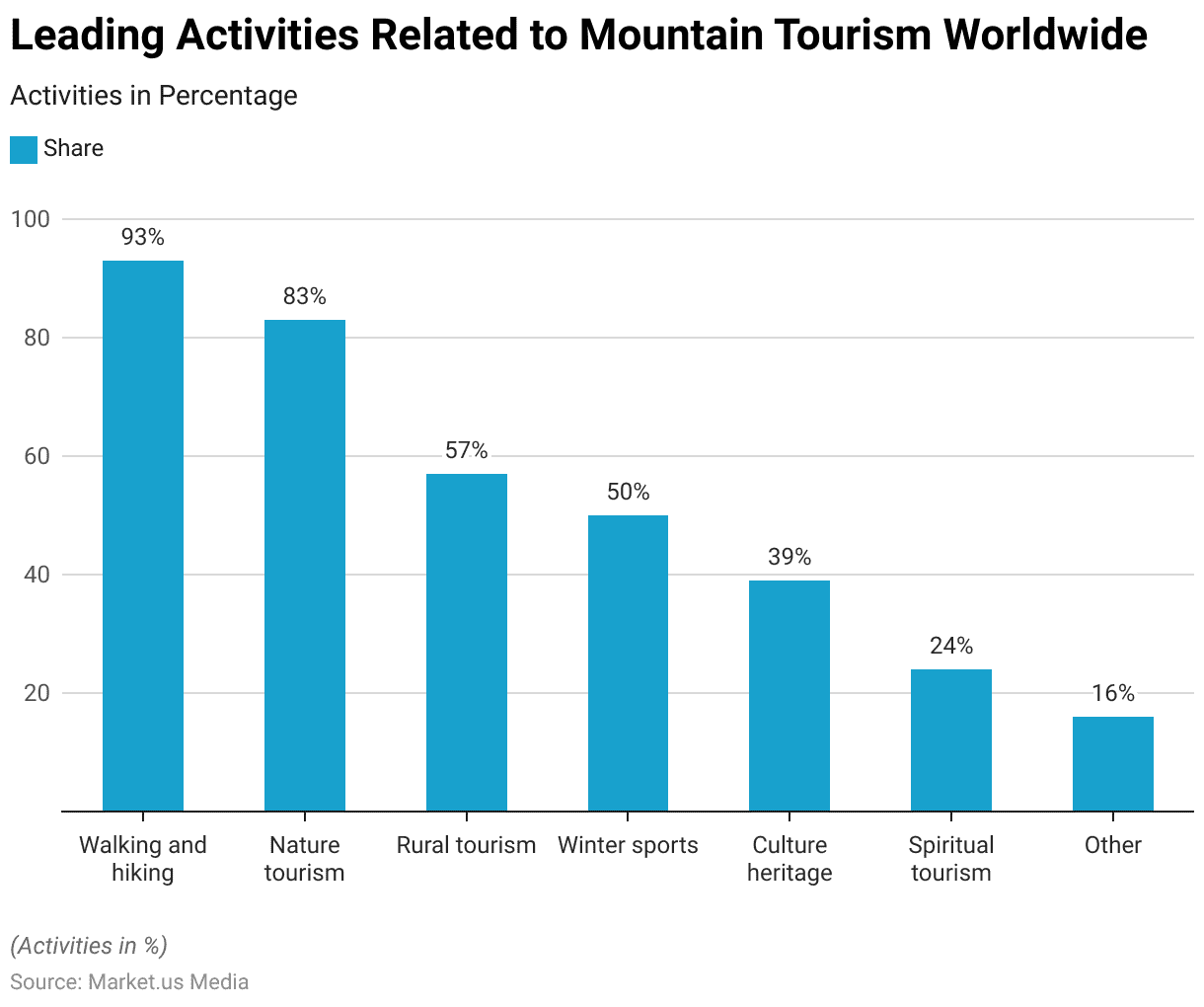
Longest Hiking Routes in the World
- As of 2021, the Great Trail in Canada ranked as the longest hiking route worldwide, extending approximately 27,000 kilometers.
- In the United States, the Great Western Loop followed as the second longest trail, with a length of 11,100 kilometers, while the American Discovery Trail spanned 10,900 kilometers.
- The Eastern Continental Trail, also located in the United States, measured 8,690 kilometers.
- The North Country Trail and the Great Western Trail, both in the United States, covered 7,400 and 7,170 kilometers, respectively.
- Italy’s Sentiero Italia trail extended 6,170 kilometers, making it one of the longest in Europe.
- The Continental Divide Trail in the United States spanned 5,000 kilometers, while Japan’s Hokkaido Nature Trail stretched 4,590 kilometers.
- Rounding out the list, the English Coastal Path in the United Kingdom measures 4,500 kilometers.
- These trails offer diverse experiences across various landscapes, attracting hikers from around the world.
(Source: Statista)
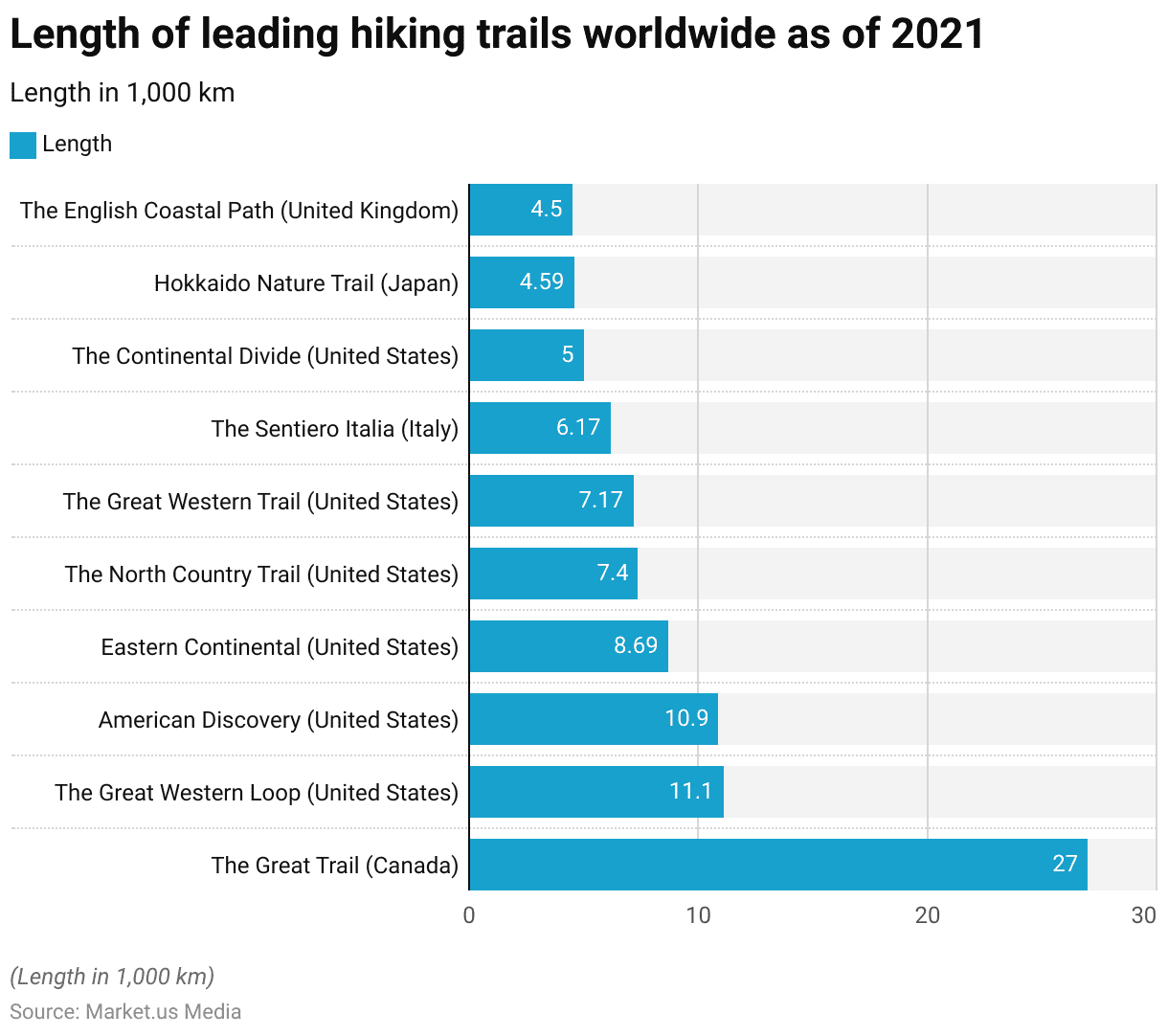
Death Rates of Mountains Worldwide
- As of May 2023, Annapurna I has the highest summit-to-death ratio among major mountains worldwide, with 27.2% of climbers who reach the summit not surviving.
- K2 follows closely with a 22.8% death rate, while Nanga Parbat holds a similar risk level with a 20.75% summit-to-death ratio.
- Kangchenjunga has a 15% fatality rate among summit attempts, and Dhaulagiri I records 13.5%.
- Other high-risk peaks include Manaslu at 12.4%, Makalu at 10%, and Gasherbrum I with a summit-to-death ratio of 9.71%.
- Shishapangma and Broad Peak also present significant risks, with death rates of 8.85% and 8.37%, respectively.
- In comparison, Mount Everest, though often regarded as dangerous, has a lower summit-to-death ratio of 3.29%.
- Even lower risk levels are found on Lhotse (2.57%), Gasherbrum II (2.3%), and Cho Oyo, which has the lowest ratio among these peaks at 1.35%.
- This data underscores the varying levels of risk associated with climbing some of the world’s highest mountains, with Annapurna I, K2, and Nanga Parbat standing out as the most perilous peaks in terms of climber fatalities relative to summit attempts.
(Source: Statista)
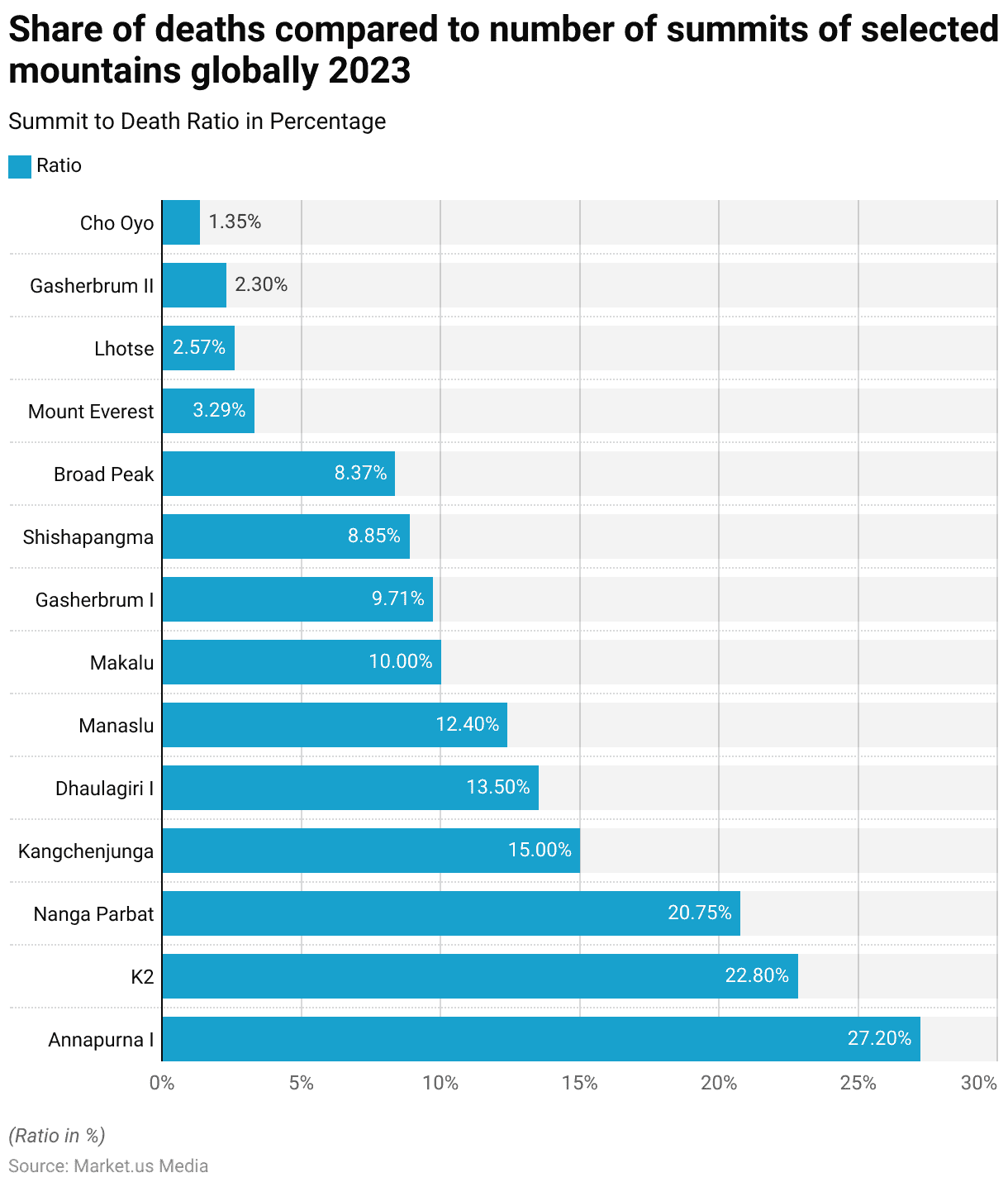
Causes of Hiking Accident, Deaths Across Various Altitudes Statistics
- In hiking deaths across various altitudes, traumatic brain injury emerged as the leading cause, accounting for 74% of all fatalities.
- The incidence of traumatic brain injury was higher at elevations above 1800 meters, where it contributed to 85% of deaths, compared to 62.2% at lower altitudes.
- Neck fractures were responsible for 18.2% of deaths overall, with a higher occurrence above 1800 meters (25%) than below (10.8%). Chest trauma accounted for 37.7% of deaths, occurring slightly more frequently at higher altitudes (40%) compared to lower altitudes (35.1%).
- Blood loss was the cause of death in 22.1% of cases, with its incidence increasing from 16.2% at altitudes below 1800 meters to 27.5% at higher elevations. Drowning was more common at lower altitudes, responsible for 5.4% of deaths below 1800 meters but only 2.5% above.
- Asphyxiation occurred in 3.9% of fatalities overall, with a slightly higher incidence at elevations above 1800 meters (5%) compared to lower altitudes (2.7%). Hypothermia accounted for 5.2% of deaths, with most cases occurring below 1800 meters (8.1%) as opposed to 2.5% at higher altitudes.
- Other causes included fat embolism, which was rare at 1.3% overall, occurring at lower altitudes (2.7%) and not reported above 1800 meters. Unclear causes accounted for 5.2% of deaths, with a nearly even distribution between lower (5.4%) and higher (5%) altitudes.
- Non-categorized causes made up 6.5% of cases, predominantly affecting those at lower altitudes (10.8%) compared to 2.5% above 1800 meters.
- This data reflects the variance in causes of hiking fatalities based on altitude, with traumatic brain injuries and chest trauma being more prevalent at higher elevations.
(Source: National Library of Medicine)
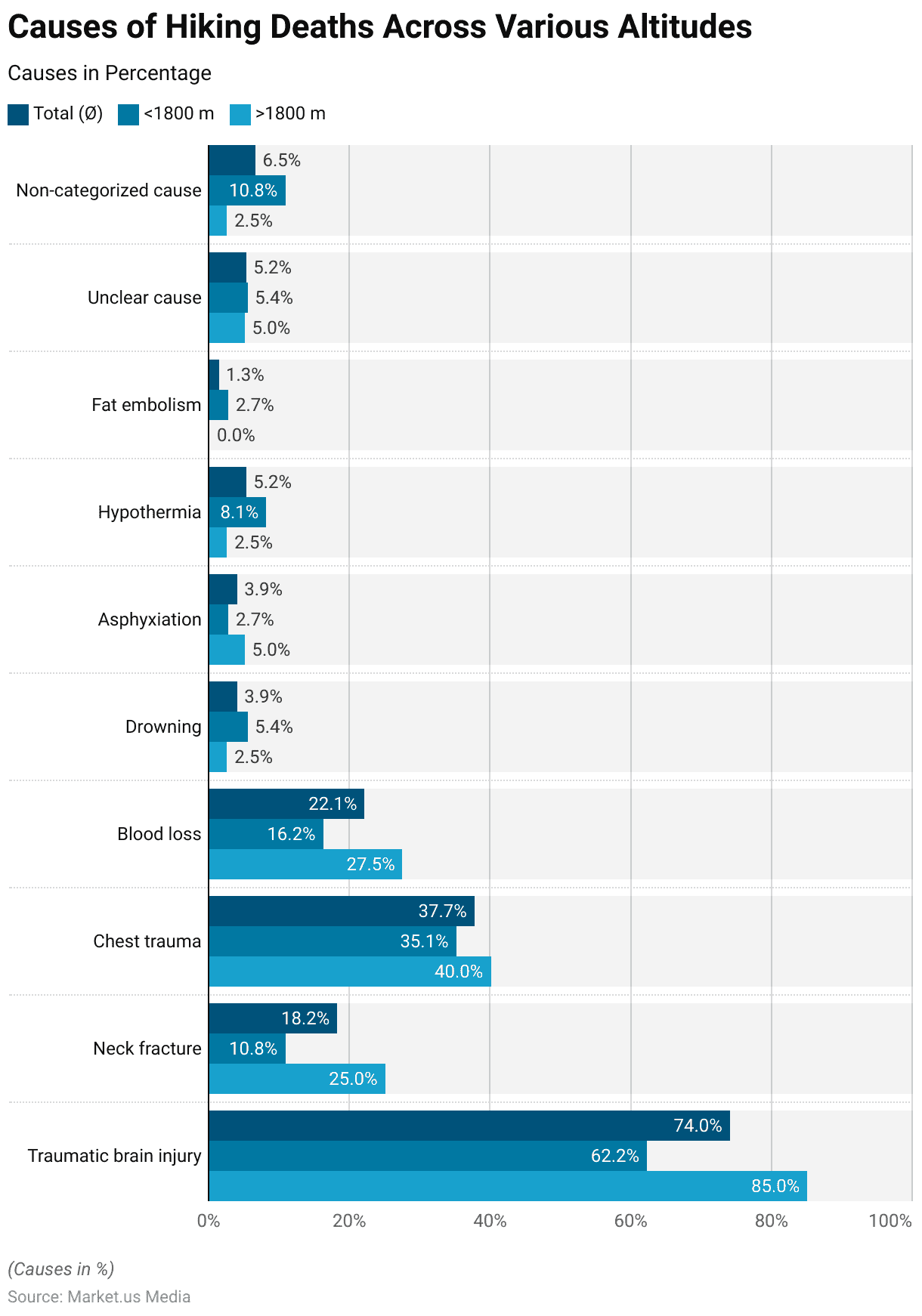
Terrain Around Hiking Accident Sites Across Various Altitudes Statistics
- The terrain surrounding hiking accident sites varies significantly across altitudes. Overall, rocky terrain was the most common environment, present in 62.3% of accident sites.
- At altitudes above 1800 meters, rocks were even more prevalent, appearing at 72.5% of sites, compared to 51.4% at lower elevations.
- Rubble was also frequently encountered, making up 48.1% of accident sites overall, with a slightly higher occurrence at higher altitudes (52.5%) than below 1800 meters (43.2%).
- Grass-covered terrain was present in 35.1% of accident sites, with a marked increase in higher-altitude areas, where it constituted 47.5% of sites, compared to 21.6% at lower elevations.
- Forested areas were observed at 29.9% of accident sites overall; however, they were predominantly located below 1800 meters, accounting for 56.8% of sites at lower altitudes, and were rarely encountered above 1800 meters (5%).
- This data suggests that higher elevations are more likely to have rocky, grassy, or rubble-strewn terrain, while forested areas are primarily confined to lower altitudes.
(Source: National Library of Medicine)
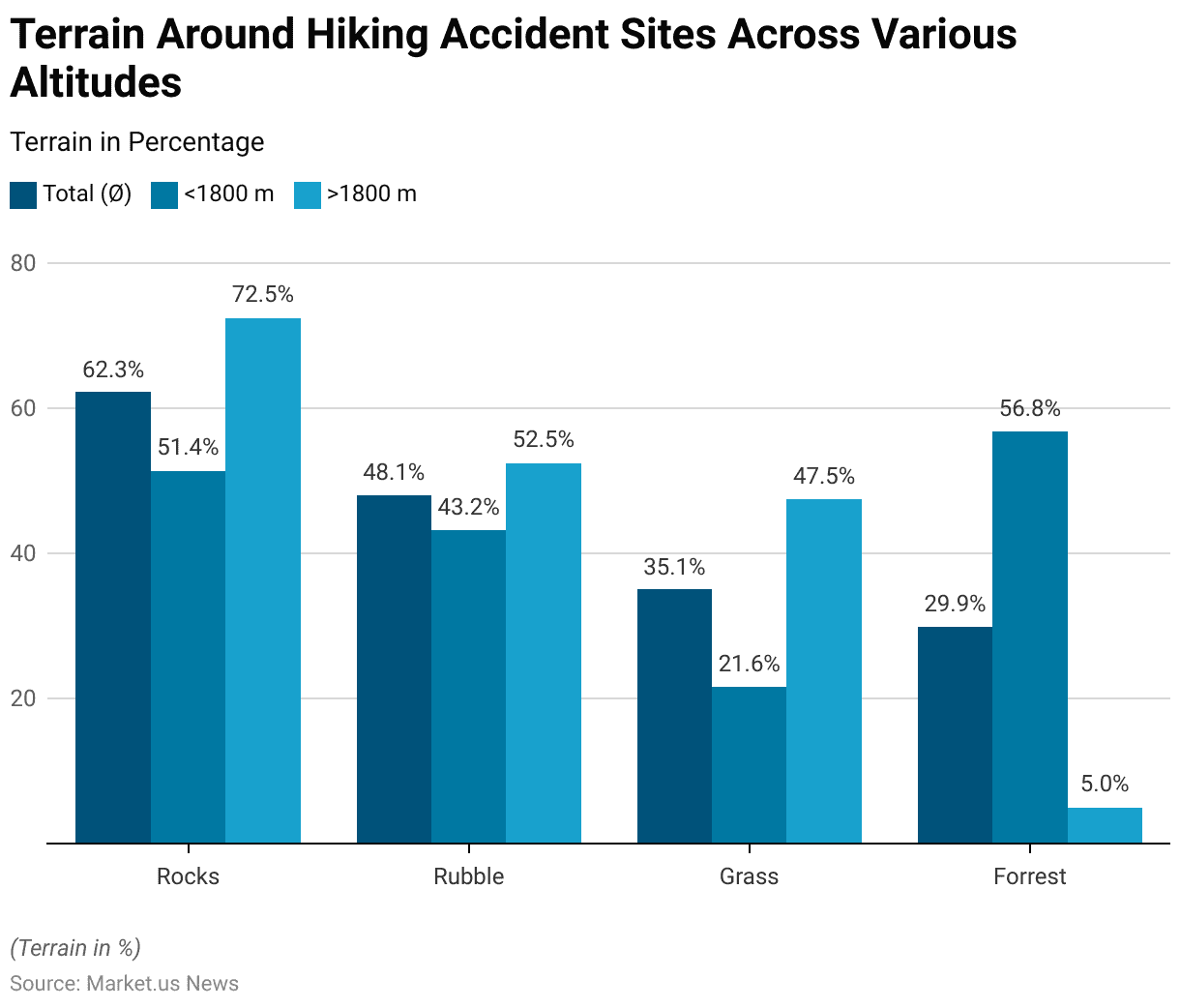
Hiking Accidents in Asia-Pacific Statistics
Causes of Fatalities in Mountain Hiking Climbing and Trekking Accident in India Statistics
- Between 2018 and 2022, avalanches emerged as the leading cause of fatalities in mountain climbing and trekking accidents in India, accounting for 35% of all deaths.
- Forest fires followed closely, contributing to 30% of total fatalities in such incidents.
- Falls represented another significant cause, accounting for 7% of fatalities, while vehicle (SUV) accidents made up 17%.
- Severe weather conditions and snowfalls, though less frequent, were also notable causes, contributing 4% and 3% of fatalities, respectively.
- Falling into rivers accounted for 1% of deaths, while unidentified or unknown events comprised an additional 3%.
- This data highlights the diverse and hazardous conditions faced by individuals engaging in mountain climbing and trekking activities in India, underscoring the need for comprehensive safety protocols.
(Source: Adventure Sports Accidentology)
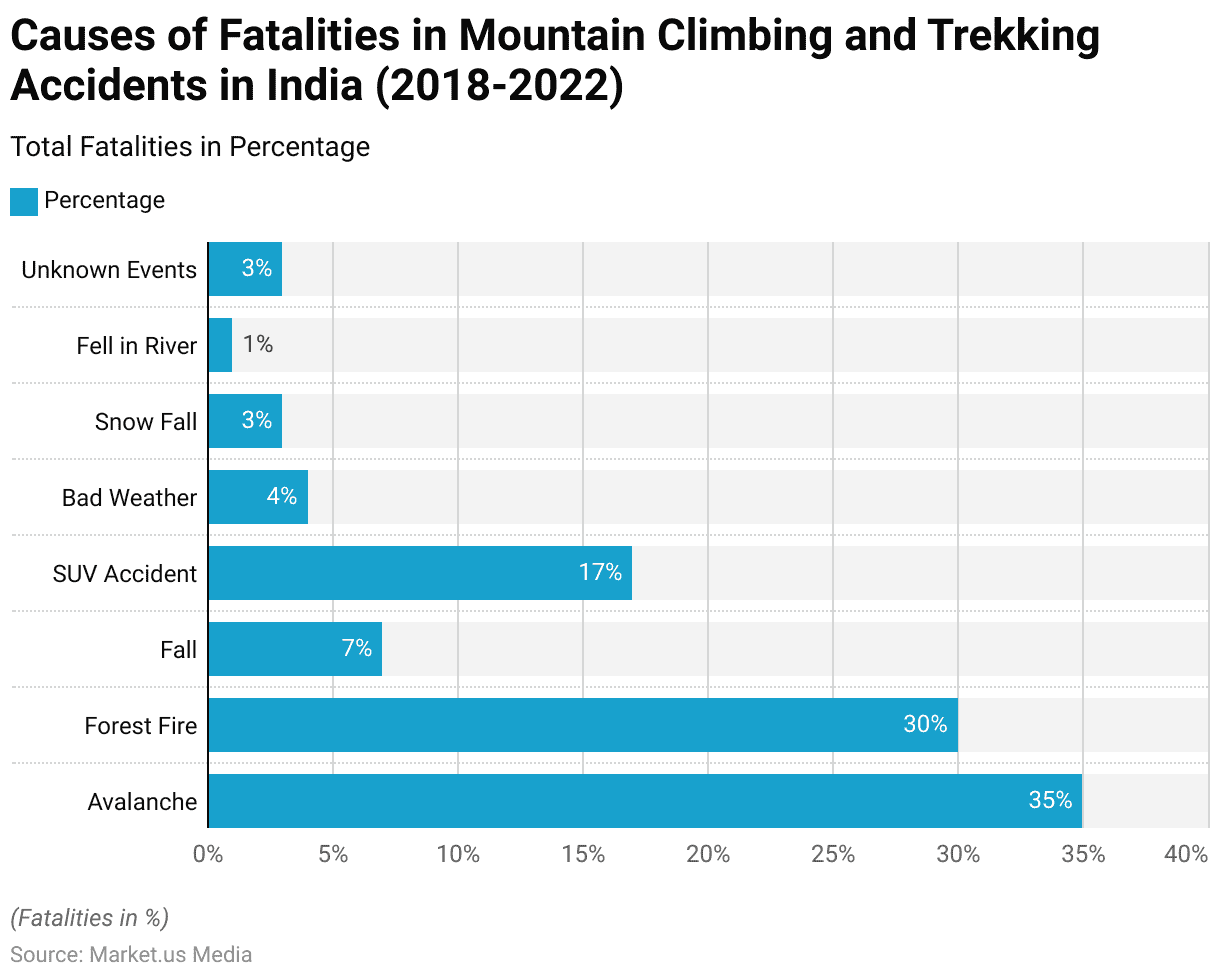
Outcomes in Mountain Hiking, Climbing, and Trekking Accident in India Statistics
- In India, mountain climbing and trekking accidents result in a high fatality rate, with deaths accounting for 61% of all outcomes, indicating a significant risk associated with these activities.
- Additionally, a notable portion of individuals involved in such accidents sustain injuries, comprising 23% of total outcomes.
- Rescues are comparatively less frequent, with only 16% of individuals being successfully saved in these incidents.
- This data highlights the considerable dangers inherent in mountain climbing and trekking, emphasizing the need for enhanced safety measures and preparedness.
(Source: Adventure Sports Accidentology)
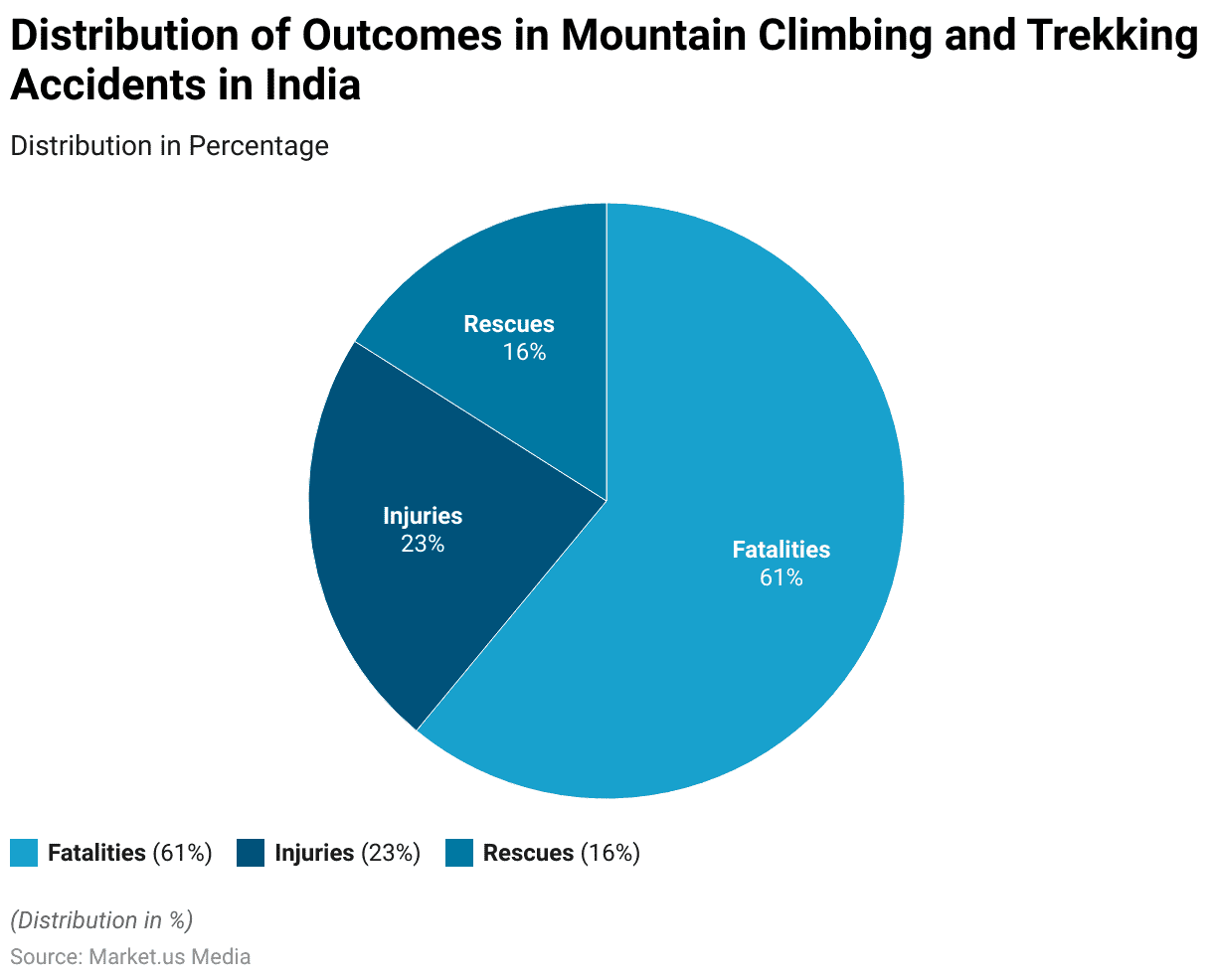
Mountain Hiking Accident Victims in Japan – By Activity Statistics
- In Japan, during 2023, mountain climbing was the most common activity associated with mountain accidents, involving 2,761 individuals.
- Accidents related to collecting edible wild plants or mushrooms accounted for 334 victims, highlighting the risks involved in this activity as well.
- Other activities contributed to 473 accident victims.
- This data underscores the significant number of accidents occurring in mountainous areas in Japan, with mountain climbing presenting the highest risk among reported activities.
(Source: Statista)
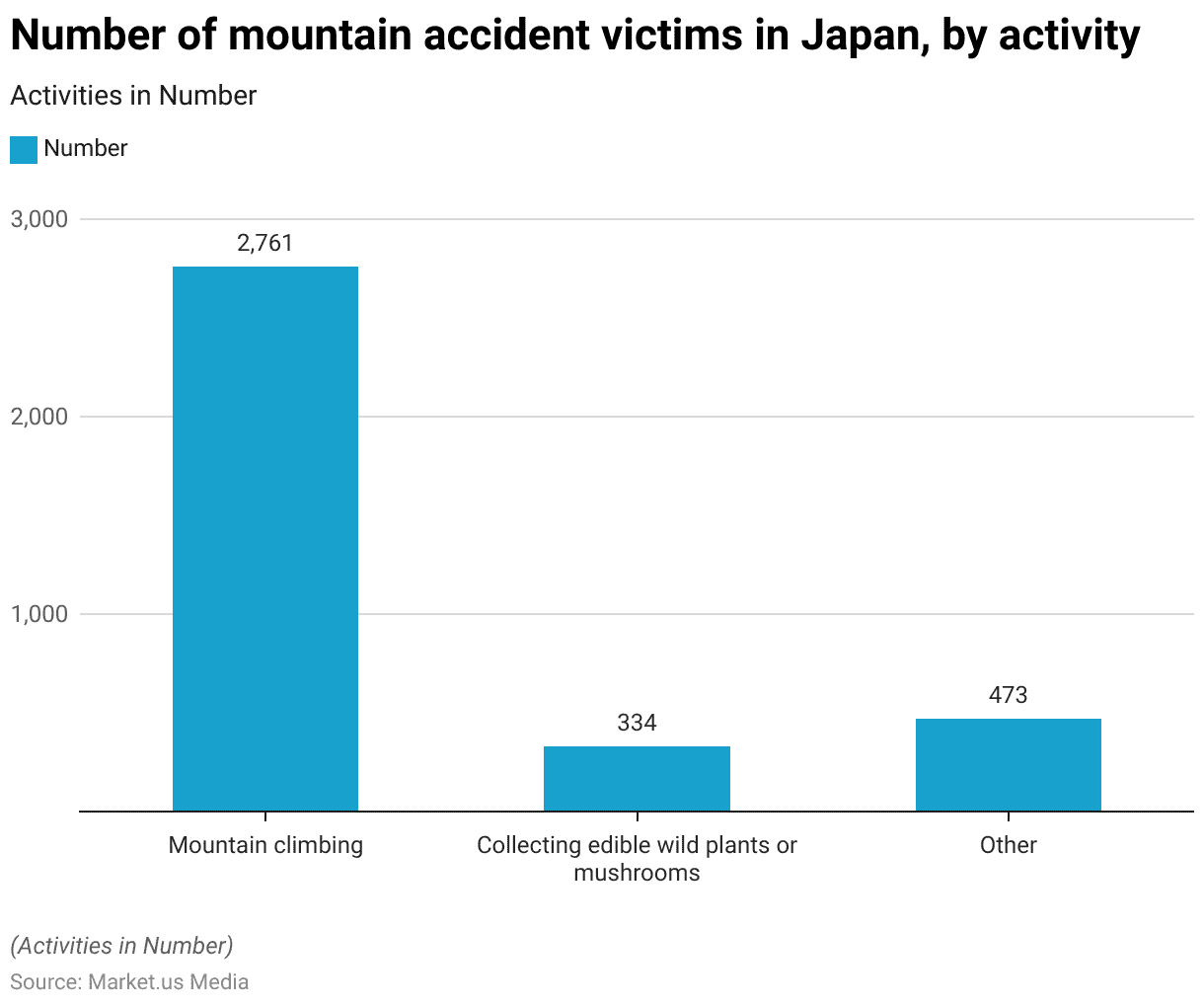
Mountain Hiking Accident Victims in Japan – By Type Statistics
2014-2018
- From 2014 to 2018, the number of mountain accident victims in Japan varied across categories of fatalities, missing persons, and those rescued with or without injuries.
- In 2014, there were 272 fatalities, 39 missing individuals, 1,041 rescues involving injuries, and 1,442 rescues without injuries.
- In 2015, fatalities rose to 298, with 37 missing, 1,151 rescued with injuries, and 1,557 unharmed rescues.
- The following year, 2016, saw 278 fatalities, 41 missing persons, 1,133 injured rescues, and 1,477 unharmed rescues.
- A peak in fatalities occurred in 2017, with 315 deaths, 39 missing, 1,208 injured rescues, and 1,549 unharmed rescues.
- In 2018, fatalities remained high at 298, with 44 missing individuals, 1,201 rescues with injuries, and 1,586 unharmed rescues.
2019-2023
- The year 2019 recorded 267 fatalities, 32 missing persons, 1,189 rescues involving injuries, and 1,449 unharmed rescues.
- In 2020, a decrease was observed with 241 fatalities, 37 missing, 974 injured rescues, and 1,445 unharmed rescues, likely influenced by reduced outdoor activities.
- The fatalities increased slightly in 2021, with 255 deaths, 28 missing, 1,157 rescues involving injuries, and 1,635 unharmed rescues.
- By 2022, the numbers had risen again, with 301 fatalities, 26 missing persons, 1,306 injured rescues, and 1,873 unharmed rescues, the highest for unharmed rescues during the decade.
- In 2023, there were 293 fatalities, 42 missing individuals, 1,400 rescues with injuries, and 1,833 rescues without injuries.
- This data reflects the consistent dangers associated with mountain activities in Japan, with notable fluctuations in rescue and fatality figures over the years.
(Source: Statista)
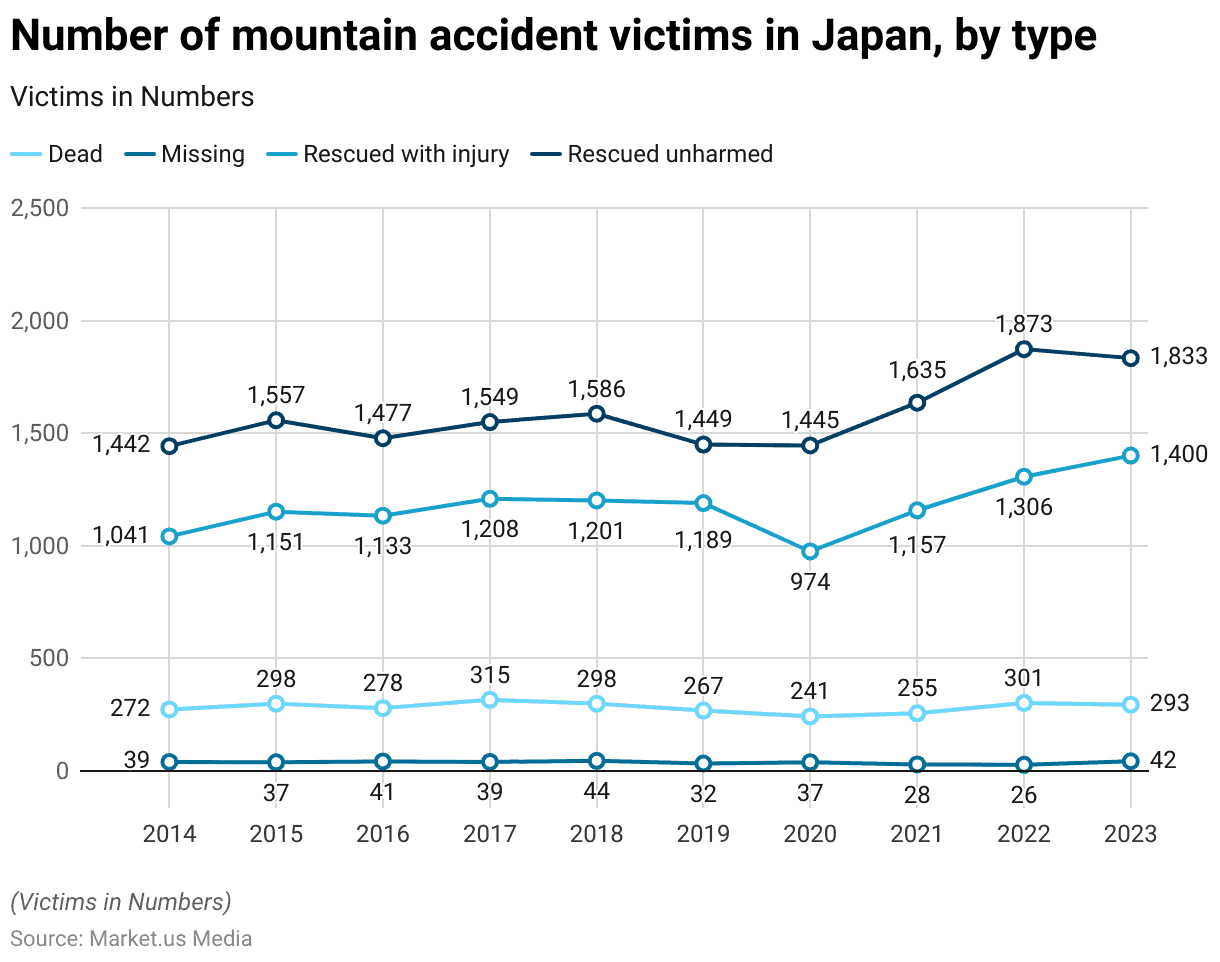
Hiking Accidents in North America Statistics
Overall
- Between 1947 and 2018, data collected from the “Accidents in North American Mountaineering” booklets reported a total of 2,799 people involved in mountaineering accidents, with 43% of these accidents resulting in fatalities.
- Women constituted 12% of the cases, and the average age of victims was 30 years.
- Falls were identified as the most common type of accident, accounting for 68% of all incidents, of which 45% were fatal.
- Other significant causes included falling rocks, responsible for 7% of accidents with a 26% fatality rate; avalanches, accounting for 6% of incidents with a high fatality rate of 75%; and falls into crevasses, which comprised 2% of accidents with a fatality rate of 52%.
- Geographically, California recorded the highest number of accidents, representing 18% of the total, followed closely by Washington at 16% and Alaska at 15%.
- Among specific locations, Denali was noted for having the highest frequency of accidents and deaths, contributing 11% of total accidents and 8% of total fatalities.
- Mount Rainier followed, accounting for 6% of accidents and 7% of fatalities, while Mount Hood recorded 2% of accidents and 3% of deaths.
- This data provides an overview of the risks and demographics associated with mountaineering accidents in North America over seven decades, highlighting both common accident types and high-risk locations.
(Source: Mary Ann Liebert, Inc., Publishers)
Climbing Accidents in the United States and Canada – By Climbing Stage
- Between 1951 and 2019, a total of 5,216 climbing accidents occurred in the United States and Canada during the ascending stage, making it the most common phase for accidents in mountaineering activities.
- The descending stage accounted for 2,030 accidents, representing a significant but smaller proportion.
- Additionally, there were 405 accidents where the climbing stage was unknown, and 65 accidents occurred during other unspecified stages.
- This data underscores the heightened risks associated with the ascending phase of climbing, which recorded the highest number of incidents over nearly seven decades.
(Source: Statista)
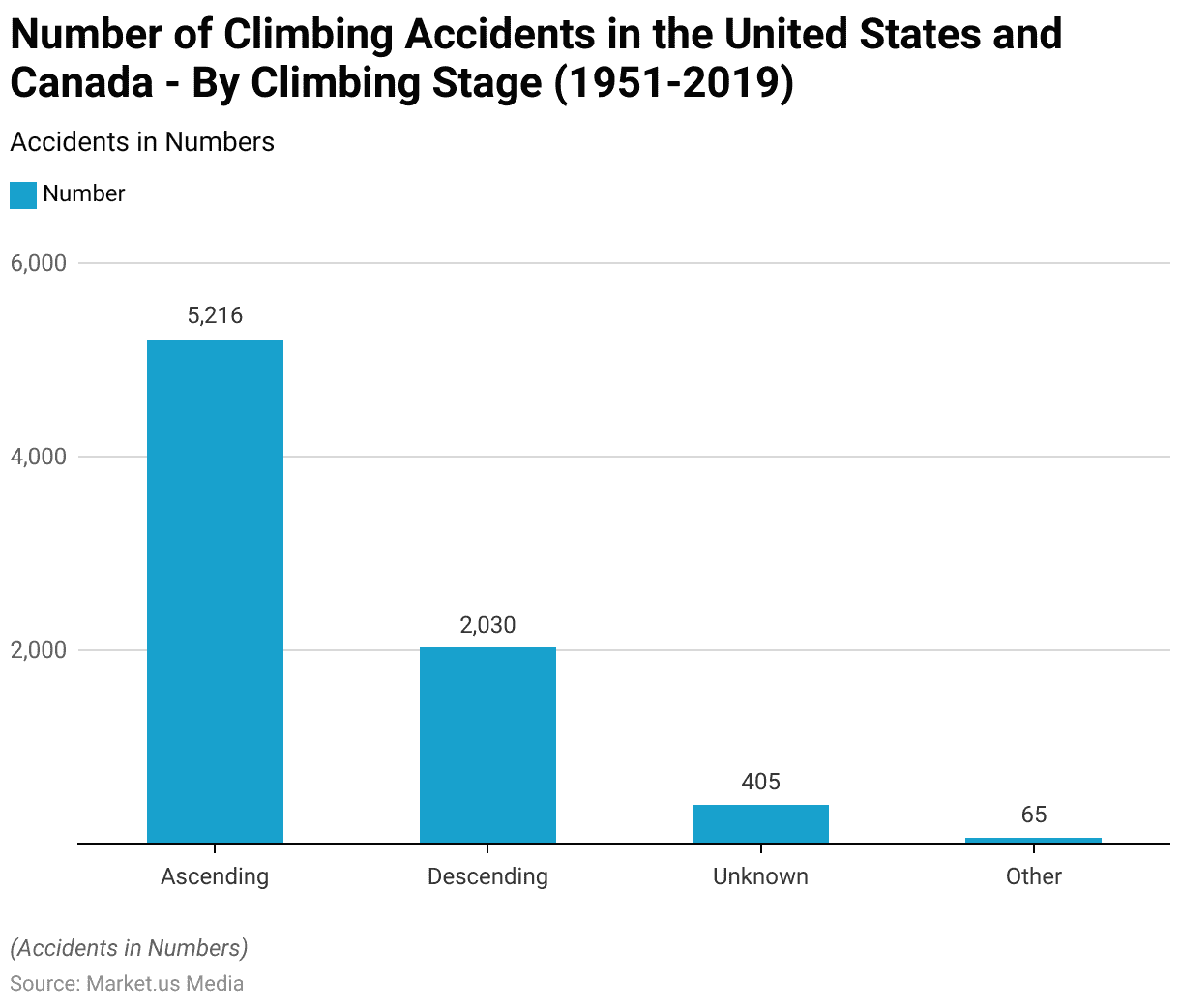
Climbing Accidents in Canadian Regions
- Between 1951 and 2019, Alberta recorded the highest number of climbing accidents in Canada, with a total of 597 incidents, indicating its prominence as a climbing destination with associated risks.
- British Columbia followed, with 362 accidents reported during this period.
- Other regions with notable accident counts included Yukon and Ontario, with 44 and 43 incidents, respectively.
- Quebec recorded 34 climbing accidents, while the Eastern Arctic Archipelago saw eight incidents, reflecting the challenging conditions in these remote areas.
- The Western Arctic Archipelago and New Brunswick reported the fewest accidents, with 2 and 1 incident, respectively.
- This data highlights the distribution of climbing accidents across Canada, with Alberta and British Columbia being the most affected regions over nearly seven decades.
(Source: Statista)
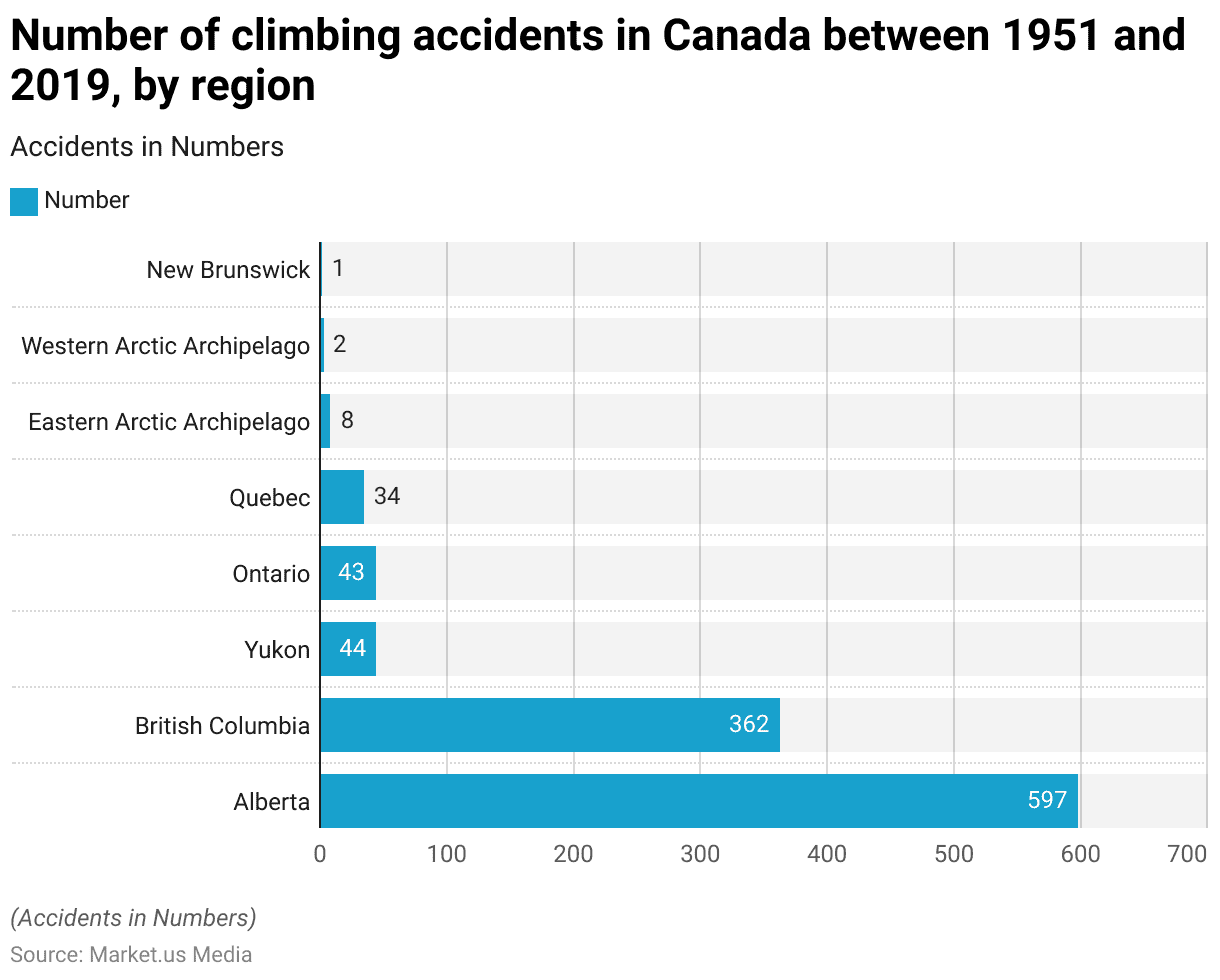
Hiking Accidents in Europe Statistics
Climbing Accidents in Germany – By Sport
- In Germany, in 2020, alpine climbing was associated with the highest number of climbing accidents, totaling 46 incidents, indicating a significant risk within this type of climbing activity.
- Sport climbing accounted for 24 accidents, reflecting a moderate level of incidents in this discipline.
- Artificial wall climbing recorded the fewest accidents, with eight incidents, suggesting comparatively lower risk levels within controlled indoor environments.
- This data underscores the heightened safety challenges in alpine climbing relative to other forms of climbing activities in Germany.
(Source: Statista)
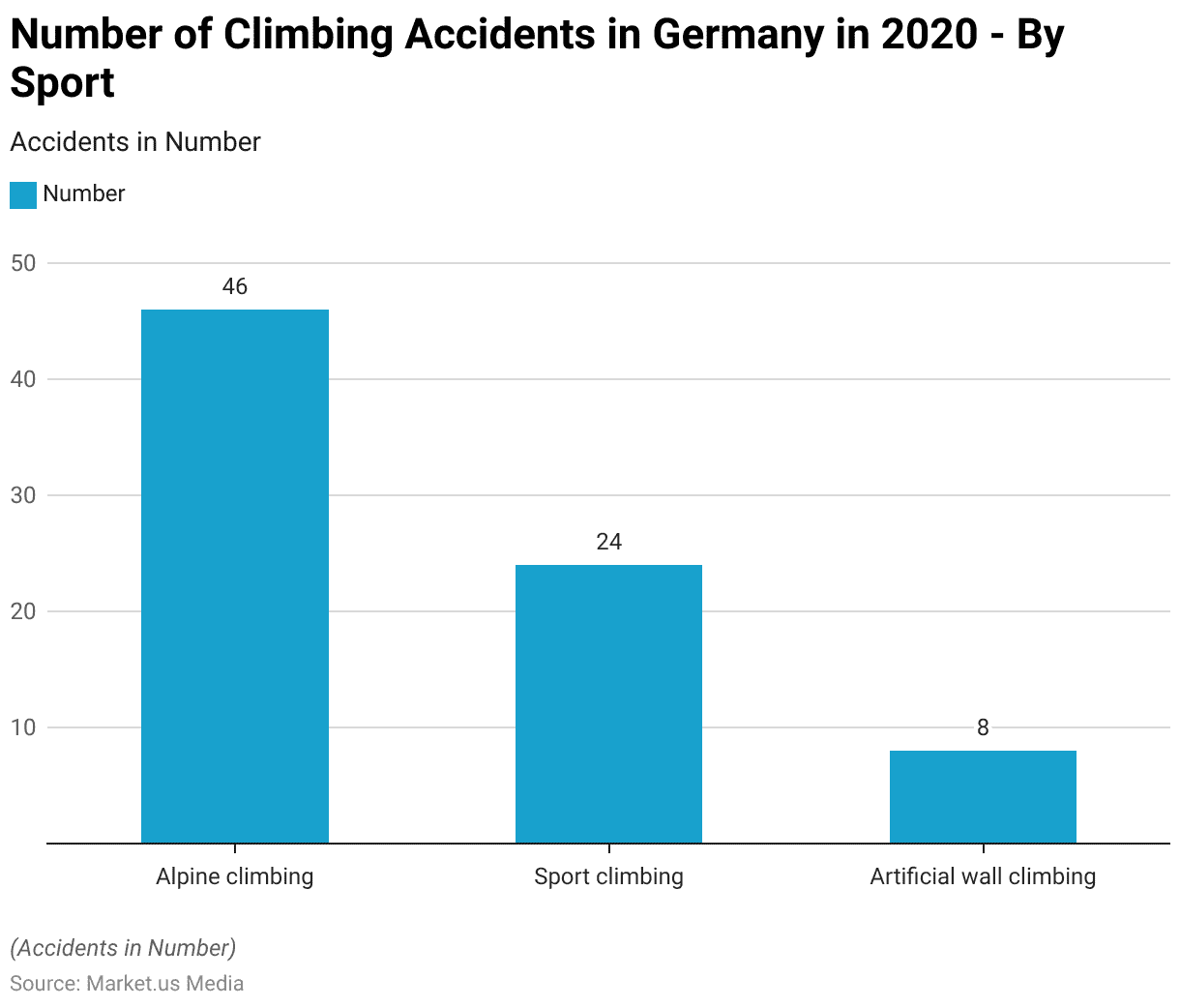
Avalanche Accidents in France During the Winter Season – By Type of Activities
- During the 2019-2020 winter season in France, avalanche accidents were most commonly associated with off-piste skiing and hiking, each accounting for 21 incidents.
- These activities, which involve high exposure to snow-covered, unstable terrains, presented significant risks during this period.
- Mountaineering was involved in 2 avalanche-related accidents, as were other non-recreational activities.
- This data highlights the prevalence of avalanche incidents among individuals engaged in off-piste skiing and hiking, underscoring the particular dangers associated with these outdoor pursuits in avalanche-prone areas.
(Source: Statista)
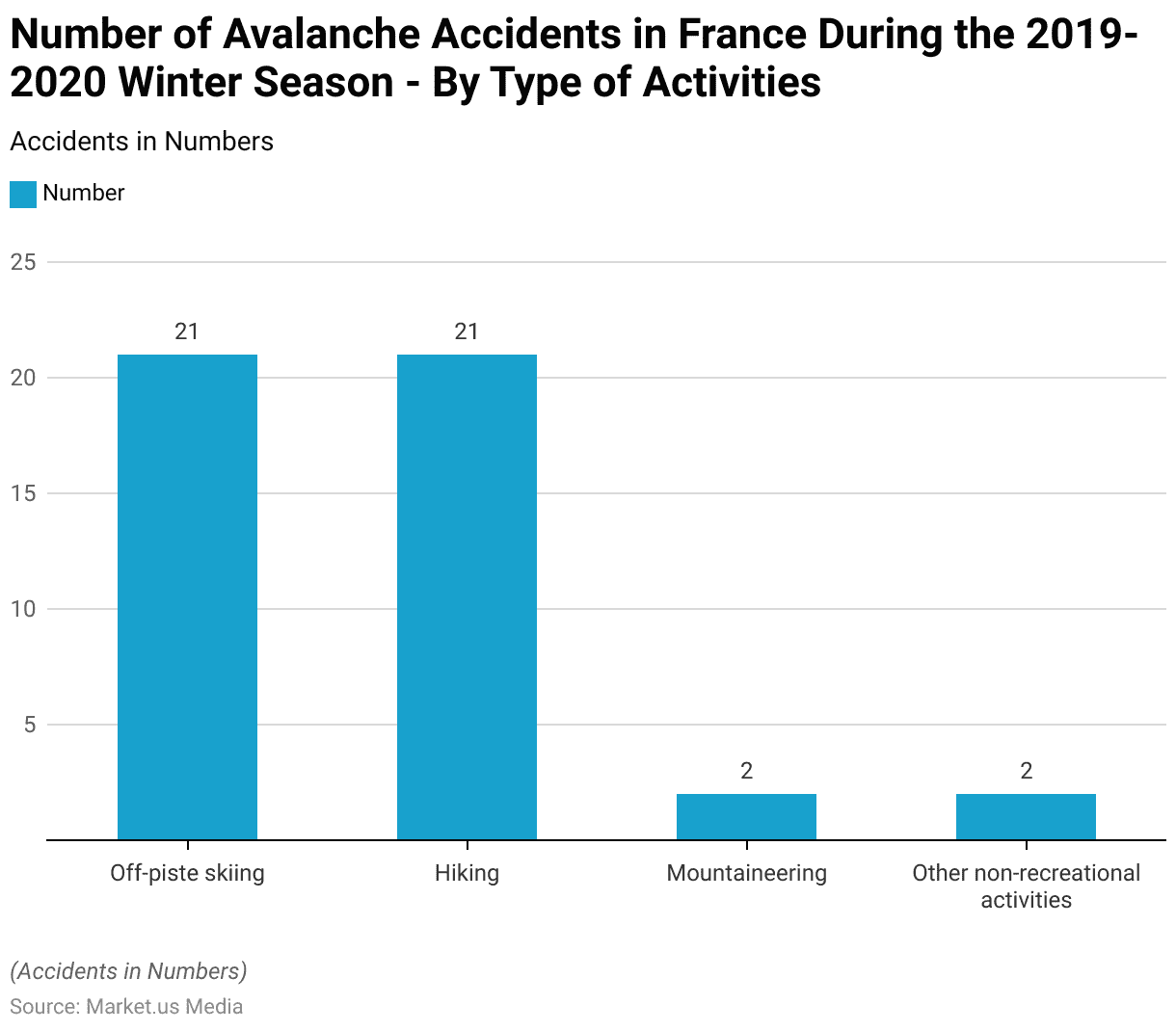
Fall-related Accidents Among Hikers in Austria
- In the Austrian Alps, fall-related accidents among hikers have been predominantly concentrated in Tyrol, which accounted for 47.9% of incidents, followed by Vorarlberg with 14.9% and Salzburg with 9.7%.
- Other provinces, such as Upper Austria (8.8%), Styria (7.6%), Carinthia (5.6%), and Lower Austria (5.6%), had moderate shares, while Burgenland and Vienna reported no accidents.
- The annual number of accidents rose steadily from 467 in 2006 to 700 in 2014. Accident altitudes ranged from 254 to 3,200 meters, with an average of 1,667 meters (±557 meters).
- The majority of accidents, 57.6%, occurred between 1000 and 1999 meters, followed by 28.6% between 2000 and 2999 meters, 13.2% below 1000 meters, and only 0.6% at 3000 meters or higher.
- Emergency calls were primarily made via mobile phones, and they were used in 77.1% of cases. Approximately 4.1% of accidents involved hikers accompanied by certified mountain or hiking guides or similarly qualified individuals.
- Weather conditions were favorable in 90% of accidents, defined as clear or partly cloudy skies without precipitation, fog, darkness, or adverse conditions.
- Falls were the primary cause, responsible for 95.4% of incidents, with 5,120 accidents involving a single victim, 215 involving two victims, and 33 incidents affecting more than two individuals.
- This data highlights the environmental and situational factors surrounding fall-related hiking accidents in the Austrian Alps, underlining the challenges even in favorable weather conditions.
(Source: National Library of Medicine)
Age Dynamics in Hiking Accident Statistics
- The age distribution of mountain accidents in Germany shows varying trends across different types of incidents, including falls, losing one’s way, blocking, and illness. In the youngest age group (0-9 years), accident rates are negligible across all categories.
- Among individuals aged 10-19, falls account for 2.0% of incidents, losing one’s way 2.1%, blocking 2.7%, and illness 1.4%, totaling 2.0% of all accidents. For the 20-29 age group, falls make up 5.4% of accidents, losing one’s way 11.8%, blocking 9.9%, and illness 5.6%, contributing to 7.1% of the total.
- Accidents peak among those in their 30s, particularly for losing one’s way (20.3%) and blocking (21.7%), with falls at 7.0% and illness at 4.8%, resulting in a total of 10.8%. The 40-49 age group follows a similar pattern, with blocking at 18.8%, losing one’s way at 13.8%, falls at 8.1%, and illness at 5.6%, amounting to 10.2% of all accidents.
Moreover
- For those in their 50s, falls increase to 13.9%, while losing one’s way is 15.3%, blocking 15.1%, and illness 9.6%, reaching a total of 13.4%. Among the 60-69 age group, falls are prominent at 21.6%, followed by losing one’s way (16.3%), blocking (14.5%), and illness (17.5%), which together constitute 18.8% of accidents.
- The 70-79 age group has the highest rates of illness at 24.7%, with falls at 23.8%, blocking at 9.6%, and losing one’s way at 10.5%, making up 19.8% of the total. For those in their 80s, illness remains high at 23.0%, while falls account for 14.4%, losing one’s way at 7.3% and blocking 4.9%, leading to a total of 13.7%.
- Accident rates drop significantly in the 90-99 and 100+ age groups, with falls at 3.6% and 0.2%, respectively, and other accident types remaining below 7.1%. This data illustrates the diverse risks faced by different age groups, with younger adults more prone to losing their way or experiencing blocking incidents. In comparison, older adults, particularly those over 60, face higher rates of falls and illness-related accidents.
(Source: German Journal of Sports Medicine)
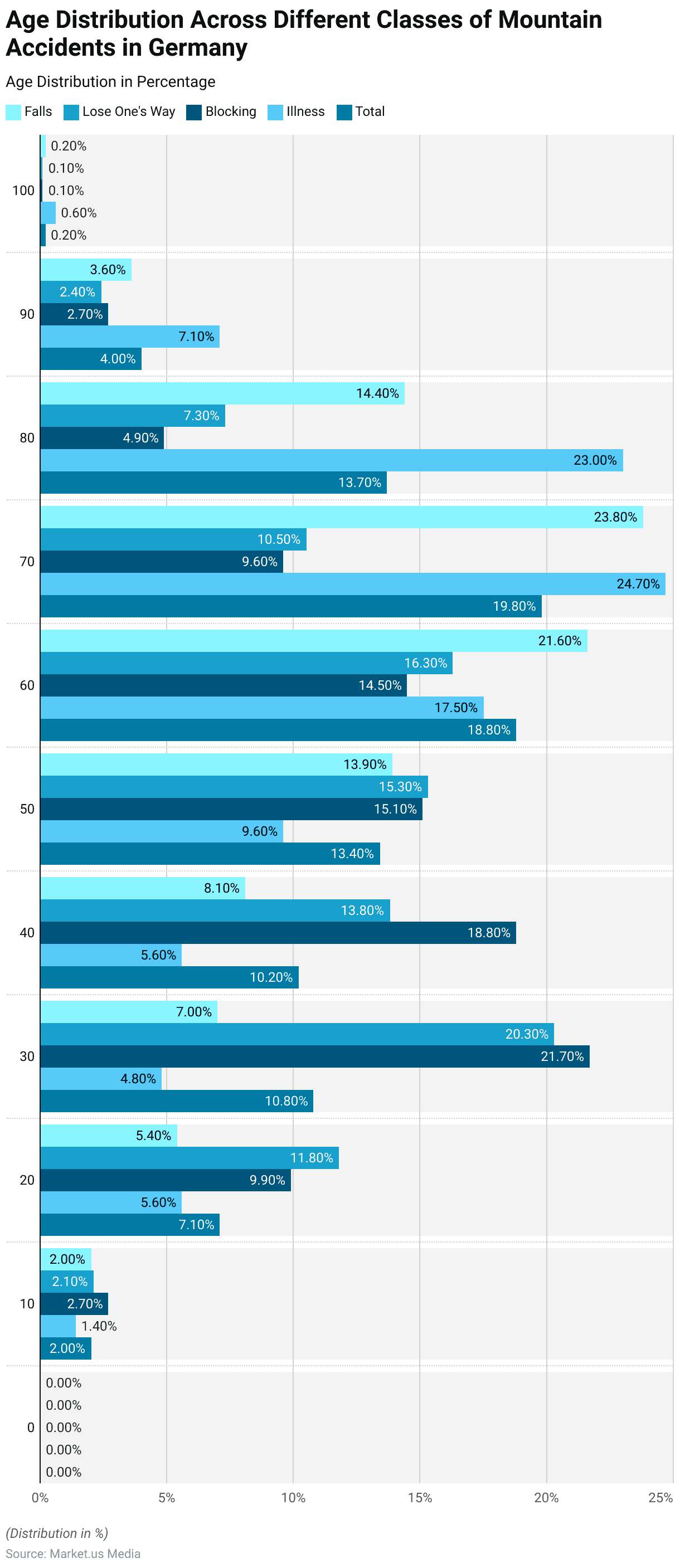
Gender Dynamics in Hiking Accident Statistics
Male and Female Victims Involved in Hiking Accident Statistics
- Over seven years, from 2015 to 2021, the number of female victims involved in hiking accidents in the Austrian Alps consistently exceeded the number of male victims each year.
- In 2021, women accounted for 703 incidents, compared to 544 incidents involving men.
- In 2020, there were 675 female victims and 569 male victims, showing a similar trend.
- The numbers were slightly lower in 2019, with 607 women and 539 men involved in accidents.
- In 2018, the figures were 553 for women and 498 for men, and in 2017, 496 women and 468 men were involved in hiking accidents.
- In 2016, female victims numbered 541, while male victims totalled 480.
- The trend began in 2015, with 437 women and 428 men affected by accidents.
- This data highlights a higher incidence of female victims compared to male victims in hiking accidents in the Austrian Alps throughout the analyzed period.
(Source: AIMS Public Health)
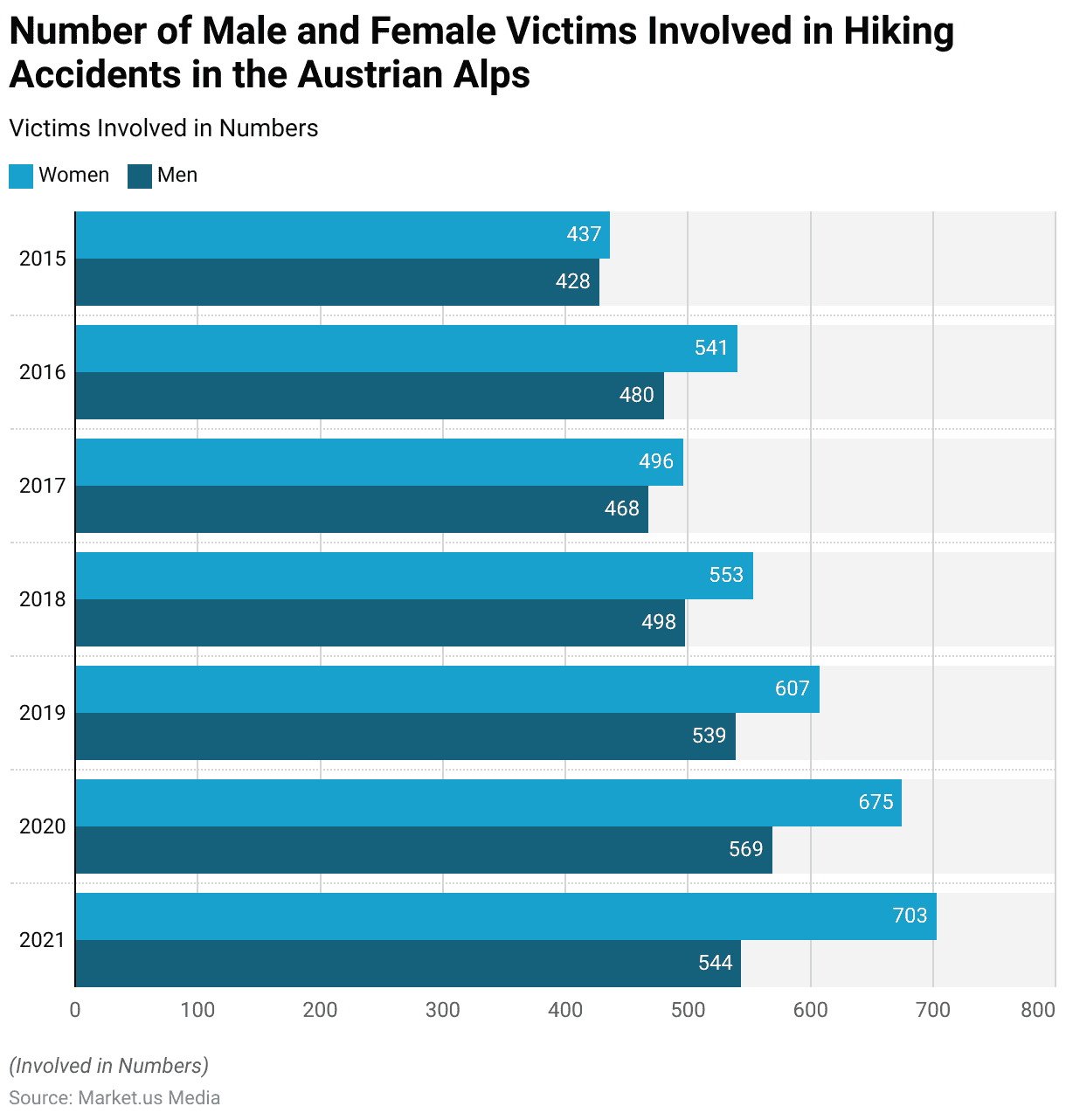
Pathophysiological Characteristics of All Victims in Hiking Accident in the Austrian Alps – By Gender Statistics
- In hiking accidents within the Austrian Alps, contusions, strains, and ruptures emerged as the most common pathophysiological characteristics, affecting 28.9% of all victims, with 16.6% of women and 12.1% of men experiencing these injuries.
- Fractures were also prevalent, accounting for 24.3% of cases, with an equal percentage (16.6%) of women and a smaller percentage (7.6%) of men affected.
- Wounds and blood loss were more frequent in men, at 7.9%, compared to 5.8% in women, making up 13.7% of the total.
- Unknown or unspecified injuries contributed to 11.9% of cases, distributed fairly evenly between genders (6.0% for women and 5.9% for men).
- Multiple types of injuries were more common in men (5.4%) than in women (3.8%), comprising 8.9% of the total.
- Cardiovascular diseases affected 5.2% of all victims, with a notable gender disparity—4.1% of men were affected compared to only 1.1% of women.
- Subluxations, sprains, and dislocations accounted for 4.7% of incidents, with a near-equal distribution between women (2.4%) and men (2.3%).
- Fatigue was the least frequent condition, occurring in 2.4% of cases, slightly more often in men (1.4%) than in women (1.0%).
- Overall, women accounted for 53.3% of the victims, while men represented 46.7%, highlighting a slight predominance of female victims in these incidents.
(Source: AIMS Public Health)
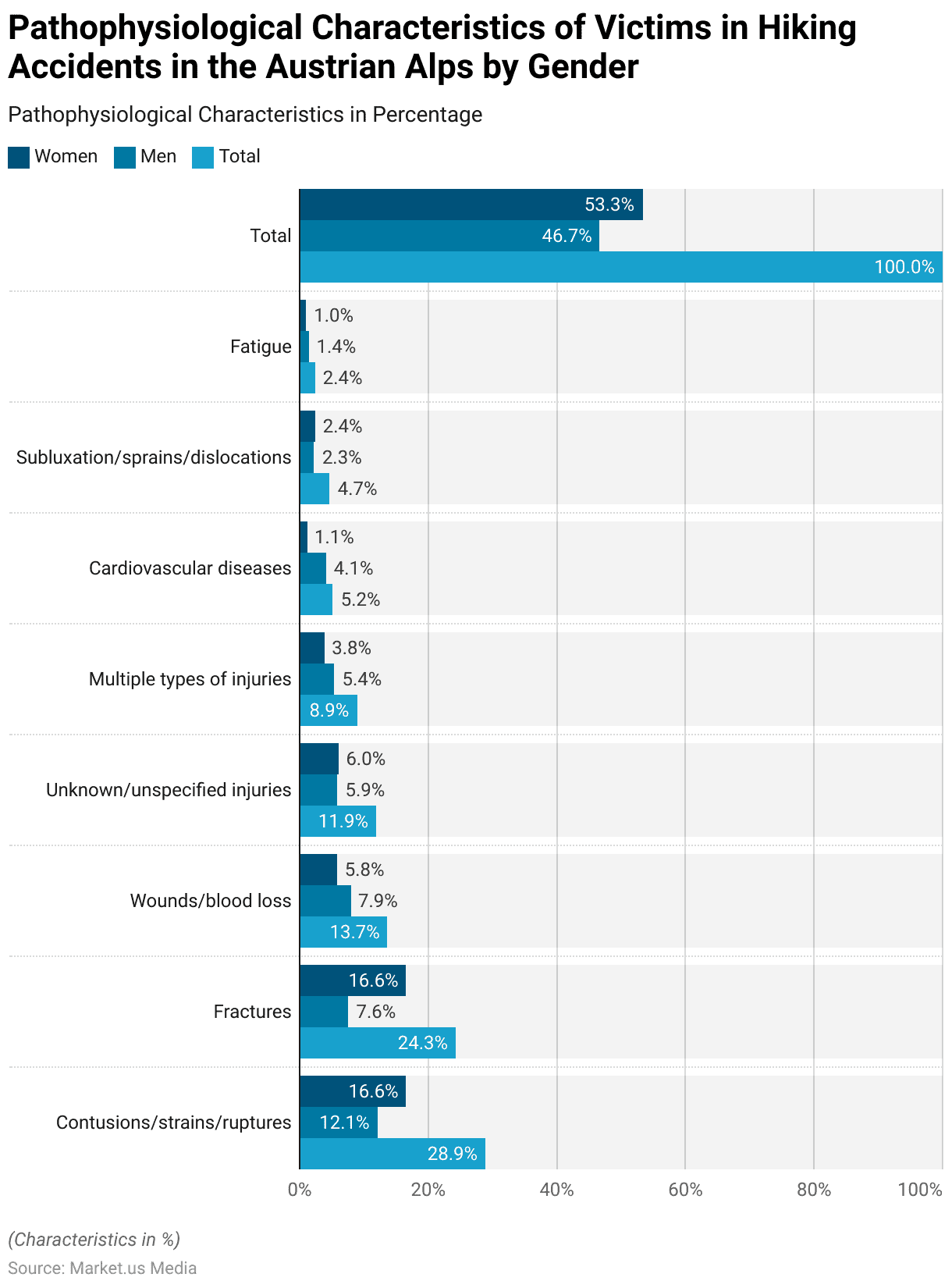
Rescue for Hiking Accident Statistics
2005-2013
- From 2005 to 2013, the Scottish Mountain Rescue (SMR) teams responded to a varying number of callouts each year, with the total hours spent on rescues reflecting these fluctuations.
- In 2005, SMR teams attended 372 callouts, spending 15,399 hours on rescue operations.
- This number increased to 396 callouts and 15,263 hours in 2006.
- By 2007, callouts rose to 463, with 17,487 hours dedicated to rescues, followed by a slight decrease in 2008, with 455 callouts and 14,150 hours.
- A significant increase occurred in 2009, with 548 callouts and 22,483 hours recorded.
- The following years showed fluctuating levels of activity, with 501 callouts and 17,663 hours in 2010 and 504 callouts and 14,272 hours in 2011.
- In 2012, callouts rose to 532, with 21,242 hours spent on rescues, followed by 540 callouts and 19,361 hours in 2013.
2014-2022
- In 2014, there were 472 callouts with 15,141 hours logged. The year 2015 marked a peak with 575 callouts and 23,396 hours spent by SMR teams.
- In 2016, callouts slightly decreased to 562, with 19,115 hours recorded. In 2017, the callouts dropped to 466, with 16,439 hours.
- This was followed by a rise in 2018 to 563 callouts, requiring 23,209 hours.
- In 2019, SMR teams responded to 534 callouts and logged 22,191 hours.
- The year 2020 saw a decrease in callouts to 480, with 19,457 hours spent. However, activity surged in 2021, with 698 callouts and a record 25,653 hours logged.
- This trend continued in 2022, with 709 callouts and 24,545 hours spent on rescue operations, marking one of the busiest years in this period.
- This data illustrates the significant time commitment required by SMR teams to respond to mountain rescue incidents, especially in recent years.
(Source: Scottish Mountain Rescue (SMR))

Initiatives to Reduce Hiking Accident Statistics
- Organizations have developed comprehensive initiatives and programs to minimize hiking accidents through public education, community involvement, and the use of technology.
- Educational programs offered by municipalities and national parks are foundational, often including workshops and seminars on trail etiquette, navigation, and first aid.
- Awareness campaigns leverage media channels to disseminate hiking safety tips, while community involvement initiatives foster mentoring relationships between experienced and novice hikers.
- Technology plays a critical role by providing hikers with tools like trail mapping apps and safety gear integrated with GPS, enhancing both preparedness and emergency response capabilities.
- The National Park Service (NPS) emphasizes the importance of planning and the use of their curated tips and tools for safe hiking experiences in national parks, advising hikers to be aware of weather conditions and wildlife and to carry essential gear.
- These comprehensive efforts aim to create a well-informed hiking community where safety is prioritized, thus reducing the number and severity of hiking-related accidents.
(Source: Hike Fuse, Madtrek Adventures, Nps.gov)
Recent Developments
Technological Advancements:
- Introduction of GPS-Enabled Safety Devices: In 2023, several outdoor equipment companies launched new GPS-enabled safety devices designed to improve hiker safety by providing real-time location tracking and emergency alerts. These devices aim to reduce the time it takes for rescue operations to begin after accidents occur.
- Wearable Exoskeletons: Research into lower-limb exoskeletons has progressed, with new models introduced in 2023 designed to reduce the metabolic cost of hiking, potentially decreasing the risk of injuries by improving walker stability and reducing fatigue.
New Product Launches:
- Smart Hiking Boots: In 2024, a major outdoor gear manufacturer introduced smart hiking boots equipped with sensors that monitor pressure points and gait patterns. These boots provide hikers with data to adjust their walking techniques in real time, aiming to prevent injuries caused by poor posture and uneven terrain.
Funding and Initiatives:
- Increased Funding for Hiking Safety Programs: The U.S. government and various non-profit organizations have increased their funding for hiking safety programs in 2024, aiming to educate hikers about the risks and necessary precautions when exploring challenging terrains.
Safety Campaigns and Education:
- Launch of ‘Hike Safe’ Campaigns: In 2023, several states in the U.S. launched ‘Hike Safe’ campaigns, providing educational resources and workshops designed to teach new and experienced hikers about the importance of preparation, proper gear, and understanding weather conditions to reduce accident rates.
Research and Reports:
- Statistics on Hiking Accident Causes: Recent studies have shown that falls and slips are the most common causes of injuries in hiking, accounting for nearly 50% of all incidents. This has led to a focus on developing footwear and tracking technologies that can offer better grip and stability on uneven surfaces.
Conclusion
Hiking Accident Statistics – Hiking accidents in mountainous terrains highlight significant risks influenced by geography, altitude, age, gender, and injury types.
Higher altitudes increase the likelihood of severe injuries like traumatic brain injuries and altitude-related illnesses.
Age and gender also affect risk, with younger hikers often losing their way and older individuals experiencing health issues.
The terrain varies with altitude, with rocky and grassy areas more common at higher levels, while forests are prevalent lower down.
Despite many accidents occurring in good weather, fatigue, trail difficulty, and lack of guidance contribute to injuries and fatalities.
This underscores the importance of safety awareness, physical preparedness, and possibly stricter regulations to reduce accident rates in high-risk hiking areas.
FAQs
Falls are the leading cause of hiking accidents, followed by injuries from rough terrain, environmental hazards (like avalanches and rock falls), and health issues such as dehydration, hypothermia, or altitude sickness.
Younger hikers often face risks related to losing their way, while older hikers are more likely to experience health-related incidents like cardiovascular problems or fatigue. Middle-aged groups tend to experience more physical injuries like fractures and sprains.
Data shows a relatively even distribution, though some studies indicate that women may be more frequently involved in certain types of accidents. At the same time, men may have higher injury severity in other cases. Differences often depend on location, terrain, and activity type.
Higher altitudes are associated with an increased risk of altitude sickness, hypothermia, and traumatic injuries. Lower altitudes tend to see more environmental hazards like forest terrain-related injuries and health issues from prolonged exertion.
While many accidents happen in good weather, poor weather conditions such as fog, rain, or snow significantly increase the risk of slips, falls, and navigation errors.
Discuss your needs with our analyst
Please share your requirements with more details so our analyst can check if they can solve your problem(s)



